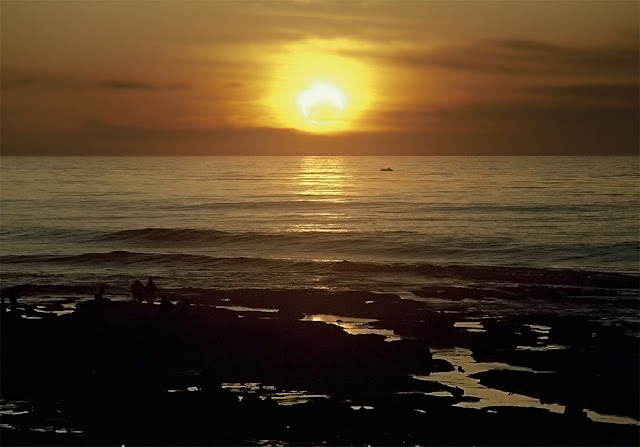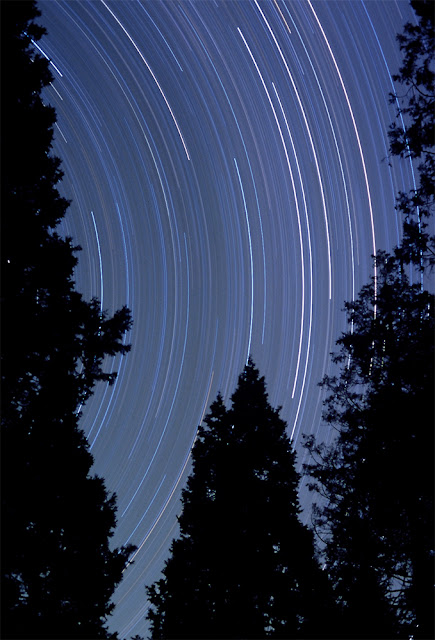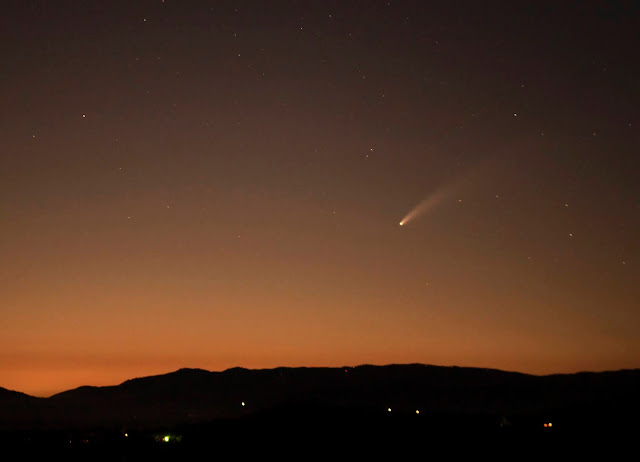Observations by Robyn and Gary Waayers on their property in Cuyamaca Woods, North Peak, Cuyamaca Mountains, San Diego County, California.
(NOTE: To see higher resolution images, click on the image as it appears in the blog narrative.)
In the Spring of 2023, we moved the old bluebird box, which had been rejected for several years in a row by the local Western Bluebirds.
We placed the box on a metal post and located it in a more open spot in the landscape, with the opening facing somewhat to the east.
 |
| Nest box in landscape. This is a mixture of open grassland, live oaks of several species, Black Oaks, and chaparral species. This area burned in 2003 in the Cedar Fire. This view is from the patio of our home. © R. J. Waayers 2023 |
The bluebirds investigated the box for several days in a row, and then rejected it and moved on.
Before long, roughly in mid-May (I was not keeping a detailed log of birds' activity at this point) a pair of Ash-throated Flycatchers showed interest in the nest box. Nest-building behavior was observed on and off, although we were busy at this time. I had been placing cat hair from the brushing of the four indoor cats in a suet feeder for a couple weeks and various local birds were seen collecting the hair, including Anna's Hummingbirds and Oak Titmice. The Ash-throated Flycatcher female collected the hair in quantities around May 21. Here is an image of her on the nest box with a billful of hair.
 |
Ash-throated Flycatcher Female with cat hair. Note that she is missing the distal portion of her right lateral toe. This helped in identifying her later.
© R. J. Waayers 2023 |
Presumably eggs were laid somewhat soon following this time, as the hair would have been used for the nest lining. Little activity was seen for the next couple weeks other than the female occasionally exiting or entering the nest box, while she presumably incubated eggs.
We were out of town from June 11 through June 15, and after returning, saw the parent birds bringing insects to the nest box, so presumably the eggs had hatched. Gary also observed a parent removing a fecal sac on the morning of June 16th, confirming the presence of nestlings.
On June 19th I photographed the parents bringing insects to the nest box. The female flycatcher, with the missing toe, preferred the perch that I had placed to the south, especially the lower curved branch. The male bird seemed a bit more shy, and typically would land either on the perch to the north, or the top of the nest box, as the images below show.
 |
| The female with a small lepidopteran of some sort. © R. J. Waayers 2023 |
 |
| The female with a small cicada. The pair captured many of these cicadas over several days. © R. J. Waayers 2023 |
 |
The female with a small "inorganic" object. She brought these fragments at least twice while I was observing. She brought them to the nest box.
© R. J. Waayers 2023 |
 |
| The male on the top of the pole. His crest was somewhat browner than the females, and the crest had a "symmetrical" spiky look to it most of the time, while hers was more "shaggy". He also has entirely intact toes. (This image was taken on May 20th) © R. J. Waayers 2023 |
The type of food items brought by the parents consisted of many, many cicadas of the small black variety with orange-red marking on their bodies, legs and wings. These cicadas may be in the genus Platypedia. Either these cicadas died off or were depleted by the birds (or both) as the birds began to bring a different, paler-colored cicada after the run with the black and orange ones, and various other smaller insect prey.
On June 20th I photographed the parents bringing cicadas as shown in the first three images below.
 |
| The female flycatcher. © R. J. Waayers 2023 |
 |
| Possibly the female flycatcher, at the nest box. © R. J. Waayers 2023 |
 |
| The female flycatcher on her favorite perch. © R. J. Waayers 2023 |
 |
| Female with a likely ant. © R. J. Waayers 2023 |
 |
| Adult emerging from nest box. © R. J. Waayers 2023 |
On several of the days that the parents were actively bringing food to the nestlings, a resident Cooper's Hawk flew rapidly through the clearing where the nest box is. Gary observed it actually make a pass at the female flycatcher one morning, and the female hurried into the nest box, with the hawk's talon possible just barely touching her tail as she escaped inside. Normally the parents would enter the box and turn around within 2-3 seconds and exit again. This time the hawk perched on the nest box pole for around a minute while the female remained inside. Then the hawk left and the female emerged a minute or so after that.
On June 21st, I photographed the parents again, and they were still actively collecting the possible Platypedia sp. cicadas. The male parent seemed less shy now, and would regularly perch on the upper southerly perch. I managed to capture a portrait of him looking earnest but a bit tired. An image of a parent emerging from the nest box with a fecal sac was also captured.
 |
| Female with cicada. © R. J. Waayers 2023 |
 |
| Female with cicada. © R. J. Waayers 2023 |
 |
| Male with cicada. © R. J. Waayers 2023 |
 |
| The hard-working father. © R. J. Waayers 2023 |
 |
| Parent emerging with fecal sac. © R. J. Waayers 2023 |
After June 21st, the nestlings were heard vocalizing in the nest. The parents continued to bring the nestlings food almost non-stop during daylight hours each day. By around June 27th, the nestlings were occasionally visible in the entrance hole. Each day they became more noticeable in the hole, and were vocalizing more loudly. We guessed that the fledging was imminent on June 28th, and we had a spotting scope and my camera on a tripod set up on our patio aimed at the nest box on June 29th. Around mid-morning on the 29th I photographed a nestling gaping in the entrance hole.
 |
| Nestling in hole. © R. J. Waayers 2023 |
Other nestlings were peeking out more frequently than they had on previous days. Both parents were frequently on or near the box simultaneously, as shown below.
 |
| © R. J. Waayers 2023 |
We had the windows open on the house and by late morning, the noise from the parents vocalizing almost constantly and the nestlings twittering incessantly in the box reached a crescendo, and we decided to see what was happening. Within seconds of arriving on the patio, a nestling was leaning far out of the box and I focused the camera on the hole. A young bird emerged. We may have missed prior fledglings, but for the sake of this narrative, I will call this bird Fledgling #1.
 |
| Fledgling #1 just before fledging. © R. J. Waayers 2023 |
 |
| Fledgling #1 fledging. |
Within three minutes, three more young birds fledged! They did not wait long to fly out into the brand new world (for them), and flew quite well. All flew towards the parents who were in the small trees to the south of the nest box, except Fledgling #3, who spent a bit more time staring at the surroundings before making the leap, and then flew straight up to the patio where we were! This fledgling landed on a large brick of the outer retaining wall surrounding the patio, looked around for a few seconds, and then flew towards the parents and its siblings.
Here are Fledglings #2 through #4 leaving the nest.
 |
| Fledgling #2 fledging. © R. J. Waayers 2023 |
 |
| Fledgling #3 just before fledging. It leaned out and looked around longer than its siblings had, and was clearly a bit confused about where to fly - initially. Then it went to its family! |
 |
| Fledgling #3 fledging (Image 1). © R. J. Waayers 2023 |
 |
| Fledgling #3 fledging (Image 2). © R. J. Waayers 2023 |
 |
| Fledgling #4 fledging (Image 1). © R. J. Waayers 2023 |
 |
Fledgling #4 fledging (Image 2). It is flying in the direction of the rest of the family in the small trees on the edge of a manzanita stand. © R. J. Waayers 2023
|
For an hour or more after the young left the nest box, the parents and fledglings could be heard vocalizing in the thicker vegetation to the south of the nest box. Later in the afternoon the sounds were calmer and more intermittent. In the days following, the flycatchers have been visible and audible regularly outside our house.
On July 3rd, the family was seen in the small oaks just to the south of our house. The young birds looked like stubby versions of the adults.


















































